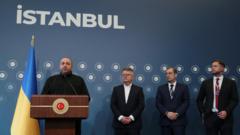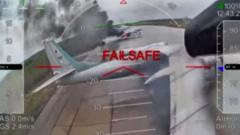An analysis of this operation reveals the tactical implications of Ukraine's drone strategy and the broader ramifications for the ongoing conflict.
Ukraine Claims Major Success in Drone Strikes Against Russian Warplanes

Ukraine Claims Major Success in Drone Strikes Against Russian Warplanes
Ukrainian security forces assert that they've successfully targeted over 40 Russian aircraft in a bold drone operation, signaling a significant escalation in aerial confrontations.
Ukraine has reported a substantial victory in its ongoing conflict with Russia, claiming that its drone strikes have severely impacted Russian military aviation. The Security Service of Ukraine (SBU) released a statement indicating that over 40 Russian warplanes have been targeted and destroyed at various military airfields, marking a significant escalation in their operational capabilities. This operation, described as a "large-scale special operation," is said to primarily aim at obliterating enemy bomber aircraft.
Footage purportedly depicting the strikes has emerged, particularly highlighting an assault on Belaya airbase located in Irkutsk oblast, Siberia, which places the operation thousands of miles away from the frontlines in Ukraine. This development raises questions about the reach and effectiveness of Ukraine's drone warfare tactics, showcasing an innovative approach to countering Russian military assets directly.
In response to these claims, the Russian military has not issued any official commentary or confirmation regarding the reported damages, a common occurrence in the often propaganda-laden narratives surrounding the war. As the situation unfolds, analysts are keenly observing the potential strategic shifts such drone capabilities could engender in the evolving dynamics of the conflict.
With Ukraine’s escalating use of drones, both sides might witness increased intensity in aerial conflicts. The implications of this operation extend beyond immediate military losses, potentially affecting morale and strategy within the Russian military command. The global community is watching closely, as this incident may redefine the tactical approaches utilized in modern warfare.
As more details emerge about this significant escalation, it remains crucial to monitor the ripple effects in the broader geopolitical landscape, particularly regarding international responses and the ongoing humanitarian crises ignited by such military activities.
Footage purportedly depicting the strikes has emerged, particularly highlighting an assault on Belaya airbase located in Irkutsk oblast, Siberia, which places the operation thousands of miles away from the frontlines in Ukraine. This development raises questions about the reach and effectiveness of Ukraine's drone warfare tactics, showcasing an innovative approach to countering Russian military assets directly.
In response to these claims, the Russian military has not issued any official commentary or confirmation regarding the reported damages, a common occurrence in the often propaganda-laden narratives surrounding the war. As the situation unfolds, analysts are keenly observing the potential strategic shifts such drone capabilities could engender in the evolving dynamics of the conflict.
With Ukraine’s escalating use of drones, both sides might witness increased intensity in aerial conflicts. The implications of this operation extend beyond immediate military losses, potentially affecting morale and strategy within the Russian military command. The global community is watching closely, as this incident may redefine the tactical approaches utilized in modern warfare.
As more details emerge about this significant escalation, it remains crucial to monitor the ripple effects in the broader geopolitical landscape, particularly regarding international responses and the ongoing humanitarian crises ignited by such military activities.


















